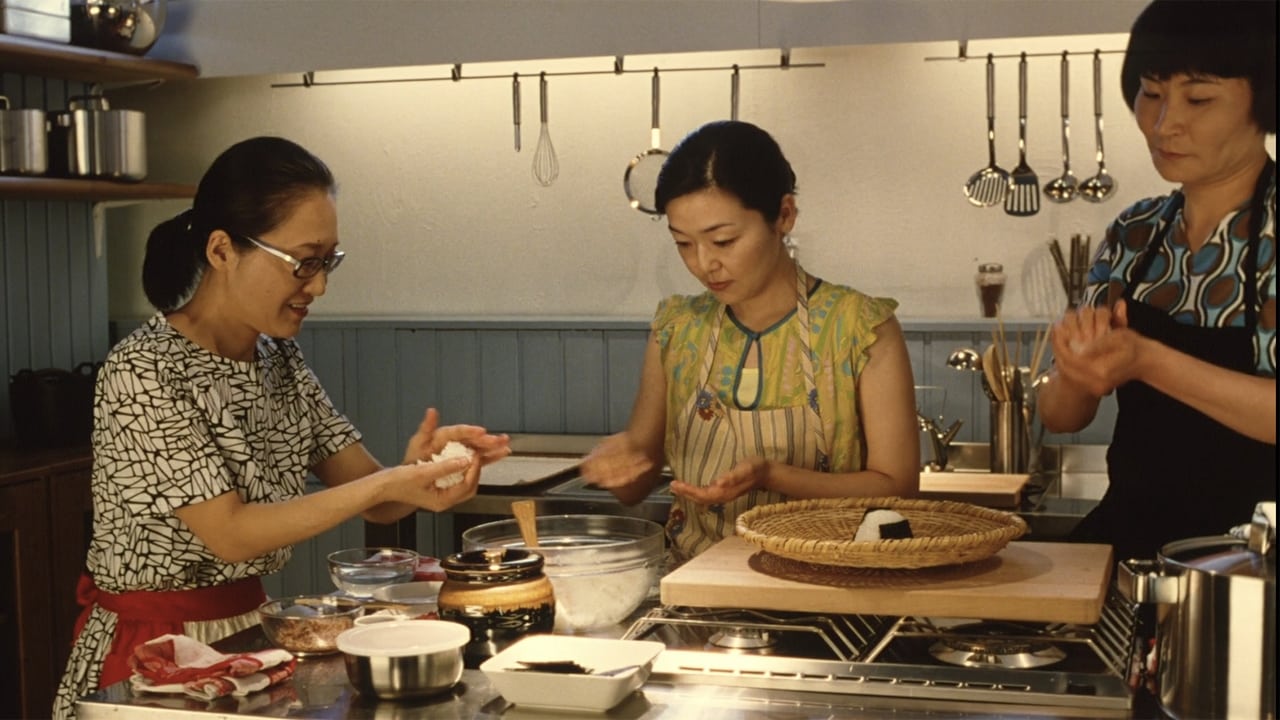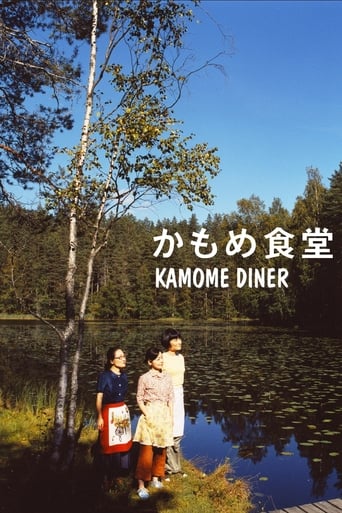RyothChatty
ridiculous rating
AshUnow
This is a small, humorous movie in some ways, but it has a huge heart. What a nice experience.
Myron Clemons
A film of deceptively outspoken contemporary relevance, this is cinema at its most alert, alarming and alive.
Janis
One of the most extraordinary films you will see this year. Take that as you want.
Christopher Culver
Although the two countries are located very far away from each other, there is a special link between Finland and Japan. After living in Finland for a few years, I have come to think of the Finns as the "Japanese of Europe" for their culture that seems alien to the rest of the West, a very reserved and homogeneous society that foreigners find nearly impossible to enter. In Japan, Finnish exports like the designers Ittala and Marimekko and the Moomins children's books have proved huge successes. The Japanese film KAMOME DINER celebrates this kinship by offering native audiences a fish-out-of-water film about Japanese women in Helsinki, but on universal themes that could appeal to viewers in Finland and beyond. The film is director Naoko Ogigami's adaptation of a novel by Yôko Mure.As the film opens, we meet Sachie (Satomi Kobayashi), who has inexplicably decided to move from Japan to Finland and open a bare-bones eatery. That she has decided to serve rice balls (onigiri), a Japanese dish virtually unknown to the rest of the world, instead of the usual sushi or tempura only makes the premise all the more absurdist. After a month, she finally gets her first customer, but it is only a local fan of Japanese culture (Jarkko Niemi) who, by long tradition, gets his coffee for free everyday since he was its first patron, and he never brings any friends. When she meets with Midori (Hairi Katagiri), a Japanese woman who has just arrived in Finland and seems lost in life, Sachie decides to bring her on at the diner. They make an odd couple, these two, as as Sachie is petite and self-confident, while Midori is tall (gigantism tall) and awkward. Nevertheless, they gradually turn their restaurant into a success while discovering something of the Finnish society around them.Any filmmaker taking on the subject of Finland is likely to pay homage to Aki Kaurismäki, Finland's most prominent filmmaker. Certainly the design of the diner, with its austerity, bleached pastel tones, and old-time decor is a typically Kaurismäkian touch. Some of the dry humor is also comparable to the the Finnish auteur, and a minor character is played by Markku Pelota, part of Kaurismäki stable. However, mainly this film lacks the bleakness or bitterness of Kaurismäki's work, and has a more straightforwardly heartwarming and cute ambiance.As a Helsinki resident who knows the quirks of the culture and can recognize all of the shooting locations, I found this an occasionally amusing film, something worthwhile. However, it doesn't feel very deep, and it may be that its themes of female solidarity will prove accessible mainly to female viewers (author Yôko Mure has a mainly female readership in Japan). There is also the frustration that, in spite of the film's attempt to attract a female audience as well, some aspects of it must be based in references to Japanese culture that foreigners won't understand. For example, is Jarkko Niemi's character being lampooned as a typical Western "wapanese", or is the tension between him and Midori based on some other factor?The English subtitles for the home-video release are high-quality, having been produced by a native English speaker. I speak Finnish and can confirm that the English subtitles mirror at least the Finnish dialogue reliably. I hope the same is true of the Japanese dialogue.
aghaemi
Kamome Shokudō (Seagull Diner in English or Ruokala Lokki in Finnish where the drama was filmed) is the story of a Japanese proprietress who has opened her café in Helsinki, Finland to realize a dream of serving Japanese soul food like onigiri. The problem is she (Satomi kobayashi as Sachie) does not have anyone walking in through her door. The film is based on a novel written by author Yoko Mure who has a mostly female following in Japan and, given the story and the largely female cast, that is also where this film's viewership might be. Why do I tell you this? The story is the kind that is likely to spur either love or hate. Disclosure: I am much more in the former camp than in the latter.Everything here is modest, the budget, the film making, the cast of characters, which corresponds to the shokudo's space, decor and menu. The goals may be modest, but when we first walk into the diner not only are those humble dreams unrealized and, moreover, there is little prospect for the better. There is openness and space everywhere - it is Finland after all and they have their forests – but either deliberately or due to time and money constraints not much of it is seen. The viewer does not see much of the area in which the diner is located or the owner's residence or the midnight sun about which we often hear. Even the marina and market shots are kept in perspective. It is a small budget in a wide open space, which is really the state of Sachie's little business. There are not that many surnames to speak of either. She is a cat out of water. She is over forty years old in real life, but passers-by are suspicious of her and comment that she is a "little thing." She has travelled from her homeland of Japan to Finland and loneliness. Yet, lucky for her and us, if there is security in numbers she is about to receive some. Just like the Japanese in real life one often wonders what the characters are really thinking or up to. Is the emotion on the sleeve (and absent) or is there something else going on? The cast ends up sharing a kinship, which they obviously need, except not one of them is readily admitting to it until later and even then barely.Elsewhere, there are a few pieces of trivia and lingering questions including spoilers. 1- Sachie opened her doors a month ago only to see it go unused. It is so sad that after a month she only has one customer (kind of). 2- Why did Midori run away the first time the otaku spoke to her inside the café? 3- Were there mushrooms in the suitcase? Could you say Pulp Fiction? 4- Why was Masako given a cat by a stranger and why did she accept? 5- Masako speaks no Finnish and yet understood that the Finnish lady's husband had left her! 6- One hopes the café would have some Japanese sign or decoration, but there were none (see above)! 7 - It was sad that the heroine's cat had died when she was younger, no one had cared and she had felt so lonely. 8- Oddly for an independent film, the credits roll and out comes Inoue Yosui's rich voice. One night in a hotel room in Japan he was on TV talking about his favourite films. Seems he and I love the same Japanese films and director, one Yasujiro Ozu. He surprisingly closes the diner here. This might pigeonhole the film and turn off many, so please do not take it as an implicit attempt at feeding you notions of a cliché, but Naoko Ogigami hits all the notes of an indie film here. This writer enjoyed the goings-on thanks to the recommendation from Osaka, Naoko Ogigami, Sachie and Japanese soul food.
Motherspot
Great Film ! Very much influenced by Finnish Filmmaker Aki Kaurismaaki. Dry humor , still and slow story of A Japanese woman trying to make it in Helsinki , running her own Diner with Japanese food. Satomi Kobayashi plays an incredible role as the main character.definitely had me falling in love with her character. A good natured film about inter-human relations.A slow film about being nice towards each other.... a humoristic sketch of events in the life of the women and her 2 other Japanese helpers , running the Diner in downtown Helsinki. Though not packed with action , this film radiates a true sense of positive human interaction. Has me longing for other work by this young director !
Tor Lillqvist
I found the film a bit boring and to tell the truth, fell asleep watching it on DVD a lazy Sunday afternoon.I found the acting especially by the young Finnish guy and the middle-aged Finnish woman less than convincing. Especially the "Koskenkorva" episode was a bit unrealistic, why would a woman who is depressed after losing her lover (or whatever the reason was) step into an empty diner, which doesn't at all look like it would even serve alcohol, and ask for a drink of vodka?But anyway, I just wanted to point out the careful selection of older and newer Finnish design classics used in the film. Aalto tables and chairs in the diner, the interiors of the Aalto-designed Academic Bookstore, Antti Nurmesniemi's coffee pots, the Hackman Tools series of pots and pans, Moomin books, and of course Marimekko clothes. Just to mention those I recognized before falling asleep.

